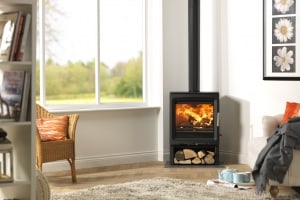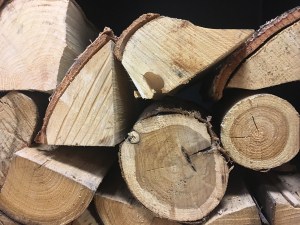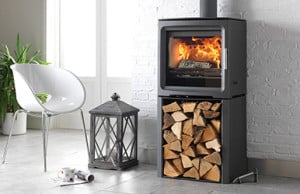 It’s October already and as the winter is getting closer, now is a great time to be looking for a stove. Showrooms are getting busier, as the colder nights start to draw in.
It’s October already and as the winter is getting closer, now is a great time to be looking for a stove. Showrooms are getting busier, as the colder nights start to draw in.
We understand that buying a wood burning stove, whether it is for the first time or a replacement is a big deal. Along with deciding on style and design, you will also have a number of questions that will no doubt arise. Below are a number of questions typically asked by people who are considering investing in a wood burning stove.
1. Should I replace my old stove?
In recent years, stoves have become much more energy efficient. This means you get the same amount of heat, from less wood. This saves you money and helps contribute to a cleaner environment. All our stoves are now ecodesign ready. In 2022 there is legislation coming into effect, which means all stoves must be ecodesign compliant. We are ahead of the game by several years, which means you can enjoy world class stove efficiency today.
We have invested a significant amount of time in research and development, to ensure that our stoves are highly efficient. You can read more about the detailed technical elements of our ecodesign stove designs here.
2. What heat output is best for me?
Stove heat output levels are important. A too larger stove for a room will make things very uncomfortable, and a too smaller one will not have the power to sufficiently heat a room. Required heat outputs can vary to a large extent, below are a few examples of quite how much this variance can be, using a set formula. As a general rule, to make a room 21°C when it’s 1°C outside, you will need 1kW of heat output for each 14 cubic metres of space.
 Room Size (medium sized lounge) – w. 18ft – h. 7ft – l. 12ft
Room Size (medium sized lounge) – w. 18ft – h. 7ft – l. 12ft
New Build – 2Kw
Uninsulated – 4.4Kw
Room Size (large lounge) – w. 25ft – h. 8ft – l. 20ft
New Build – 3.8Kw
Uninsulated – 11.6Kw
Room Size (very large lounge) – w. 30ft – h. 8ft – l. 40ft
New Build – 9.1Kw
Uninsulated – 27.8Kw
You can learn more about heating and output in a more detailed article we have produced – more info.
3. What wood can I burn?
There is a wide range of wood available to you to burn on your stove. Below is an overview of the ideal wood:
The Best Wood:
Ash – Ash is thought to be one of the very best woods for burning. Ash creates a steady flame and a good heat output. Unlike other wood, ash can be burnt when green, but like with most wood burns at it’s very best when it is dry. Ash tends to have a very low moisture content when live, which is the main reason why you can burn it when it is green.
Beech – Like ash, beech burns very well. However, it does not burn well when green due to it’s much higher moisture content when live. Beech can be identified by it’s pale cream colour with a pink or brown hue.
Hawthorn – This type of wood has a slow burn rate, and a good heat output.
Rowan – Similar to hawthorn, rowan has a very good heat output that burns slowly. Rowan is also know as Mountain Ash.
Thorn – Thorn produces very little smoke, which makes it an ideal wood where excessive smoke could be an issue.
Yew – Slow burn and produces a great, intense heat. Burning yew also produces a pleasant scent, which makes it stand out a little more over other woods.
 Other good wood:
Other good wood:
Apple – Apple has a small flame and tends to not produce sparking or spitting. The flame burns slowly and produces a good level of heat output along with a nice scent too.
Birch – Birch is similar to ash in that it can be burnt when green. It does produce a good heat output and a strong flame. Yellow Birch and Black Birch (also know as Mountain Mahogany, Sweet Birch and Cherry Birch) produces the best firewood.
Cedar – Cedar fire wood is quite distinctive as it can spit and crackle when burning. Although the flame from cedar is small, it does tend to last a long while and has a strong heat output.
Cherry – Cherry needs to be well seasoned but does burn well and produces a good heat. It is easy to split too, which is ideal if you are having to cut your own firewood.
Hazle – This is a fast burning wood, which works best when fully seasoned. Does not split unlike other woods such as cherry.
Hornbeam – This burns in a similar way to beech, which is similar to ash – both are excellent firewoods.
Horse Chestnut – This wood is ideal for burning in wood stoves but not open fires as it does spit a great deal.
Oak – Probably the best know wood in the UK for a range of reasons. It is a popular wood for furniture but also it makes great firewood. It burns very slowly and makes a small flame. It burns best when seasoned for a very long time (usually 2yrs+).
Pine –The resin sap can cause deposits to form in the flue in a chimney, which can increase the risk of a chimney fire, so use with caution. It does however produce a good flame.
4. What if I live in a smokeless zone?
All Charlton & Jenrick stoves are DEFRA capable or already exempted for burning wood in UK smokeless zones, and produce particulates and visible smoke levels 60% or more below DEFRA limits.
To view the range of Charlton and Jenrick stoves, please visit https://www.charltonandjenrick.co.uk/products/stoves/








